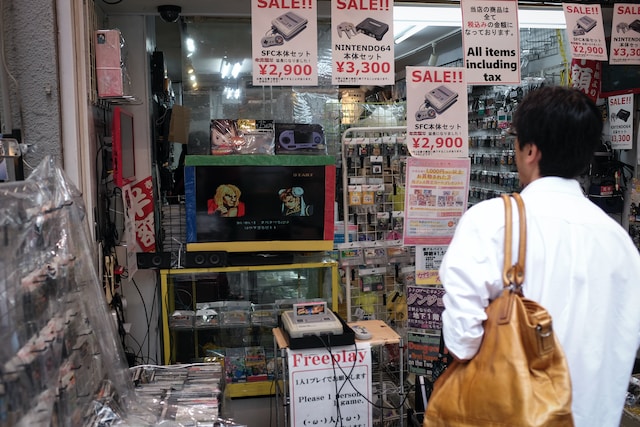Japan: a country synonymous with cultural richness and a pioneering spirit in the gaming industry. If you’re a gaming enthusiast heading to Japan, your itinerary isn’t complete without exploring the heart of Japanese gaming: its game shops. Let’s take a journey together.
1. A Brief History of Japanese Video Games
The story of video games in Japan is both captivating and pivotal to the global gaming landscape. It began in the 1970s, a decade marked by rapid technological advancements worldwide. In Japan, this era saw the birth of arcade gaming, a phenomenon that took the nation by storm. Iconic games like “Space Invaders” and “Pac-Man” first made their appearance in Japanese arcades, capturing the hearts and coins of many.
Out of this fertile ground rose gaming giants like Nintendo, Sega, and Bandai Namco. These companies didn’t just shape Japan’s gaming trajectory; they revolutionized the global scene. In 1983, Nintendo released the Famicom (known internationally as the Nintendo Entertainment System or NES). This home gaming console transformed household entertainment, moving gaming from arcades to living rooms. The Famicom, with its library of classic titles like “Super Mario Bros.” and “The Legend of Zelda”, became a cultural phenomenon.
Sega, not to be outdone, introduced the world to Sonic the Hedgehog on their Sega Genesis system in the 1990s. This period also witnessed the rise of role-playing games (RPGs), with titles like “Final Fantasy” and “Dragon Quest” offering intricate stories and vast virtual worlds.
Over the years, Japan’s innovative spirit continued to blaze trails. Sony’s PlayStation, released in the mid-90s, brought with it a shift towards more mature, cinematic gaming experiences. Meanwhile, handheld gaming saw a surge with Nintendo’s Game Boy and later the DS series, allowing gamers to take their adventures on the go.
Today, Japan’s gaming legacy is evident in its rich tapestry of genres, from action-packed titles to serene life simulation games. Its impact is profound, resonating in both the games we play and the way we play them. As technology advances, Japan continues to be at the forefront, melding traditional gaming values with cutting-edge innovation.
2. The Majesty of Akihabara
Akihabara, nestled in the heart of Tokyo, is more than just a district – it’s a pulsating hub that embodies Japan’s Otaku culture. The moment you step into its precincts, you’re greeted by a symphony of sights and sounds: flashing neon lights, lively jingles from electronic stores, and the chatter of both locals and tourists alike.
Historically, Akihabara started as a hotspot for electronics and gadgets post World War II. Over time, it evolved into the “Mecca of Otaku Culture”, catering not only to those interested in the latest tech but also manga, anime, and, of course, video games. The district is lined with multi-storied buildings, each floor dedicated to a different sub-genre, making it a paradise for enthusiasts to explore.
Among the most striking features of Akihabara are its game shops. From sprawling multi-level stores to quaint corner shops, the range is vast. Whether you’re searching for the latest RPG title, a nostalgic cartridge from your childhood, or a rare collectible item, chances are Akihabara has it.
But Akihabara’s appeal isn’t limited to shopping. The district is home to themed cafes, like the renowned maid cafes, where staff dress up in maid costumes and engage in playful banter with customers. For gamers, there are game bars, where one can enjoy vintage arcade machines while sipping on a drink.
Events and launches are another vital aspect of Akihabara’s gaming culture. Often, when a new game or console releases, enthusiasts line up for hours, sometimes days, brimming with anticipation. These events often become communal, with fans bonding over shared passions.
A walk through Akihabara also offers glimpses into the fusion of old and new. Traditional Japanese establishments stand shoulder-to-shoulder with modern gaming arcades, showcasing a seamless blend of Japan’s past and present.
In essence, Akihabara is not just a district; it’s an experience. It encapsulates the passion and dedication of Japan’s gaming community, and for any traveler with even a passing interest in gaming or Otaku culture, it’s a destination that shouldn’t be missed.
3. Super Potato – A Retro Gamer’s Paradise
In the heart of Akihabara, amidst the neon glitz and modernity, stands a beacon for those yearning for a nostalgic gaming experience: Super Potato. This iconic store is more than just a retailer; it’s a living museum of gaming’s golden age.
The exterior of Super Potato might seem modest compared to some of its flashy neighbors, but stepping inside is like being transported back in time. Every inch of the store is packed with relics from the past, from wall-to-wall shelves filled with classic game cartridges to glass cabinets showcasing vintage gaming hardware.
Upon entering, visitors are immediately greeted by rows of Famicom, Super Famicom, and Sega Genesis titles. These aren’t just any titles, but a meticulously curated collection spanning every genre imaginable. From platformers like “Super Mario Bros.” to intricate RPGs like “Chrono Trigger”, there’s a title that resonates with every retro gamer’s soul.
Super Potato also boasts an impressive range of hardware. Looking for a pristine condition Sega Saturn or perhaps a Game Boy Color in a rare shade? This store has got you covered. And it’s not just about buying; simply browsing the collection, each item meticulously labeled and displayed, offers a journey through gaming’s rich history.
One of the standout features of Super Potato is its mini arcade located on the upper floor. Here, you can relive the thrill of arcade gaming with classics like “Street Fighter II” and “Pac-Man”. The sound of coin slots, joystick clicks, and 8-bit music is a trip down memory lane.
Beyond games and hardware, Super Potato is also a haven for gaming memorabilia. Vintage posters, soundtrack CDs, action figures, and even old gaming magazines are available for purchase. These items, often hard to find elsewhere, make for perfect souvenirs to remember one’s trip by.
What truly sets Super Potato apart, though, is its atmosphere. The store staff, often clad in retro gaming t-shirts, are not just employees but enthusiasts. They’re always eager to chat, share trivia, or offer recommendations. It’s this genuine passion that gives Super Potato its soul.
In conclusion, Super Potato isn’t just a store; it’s a tribute to the games and consoles that defined a generation. Whether you’re a seasoned retro gamer or a curious newcomer, Super Potato promises an unforgettable dive into the annals of gaming history.
4. Modern Gaming: The Yodobashi and Bic Camera Experience
While places like Super Potato cater to the rich legacy of retro gaming, Yodobashi Camera and Bic Camera stand tall as symbols of the contemporary and futuristic gaming landscape in Japan. These colossal electronic emporiums are more than just stores; they are state-of-the-art showcases of the cutting edge in gaming and technology.
The sheer size of these establishments can be overwhelming. Multi-floored and spanning blocks, both Yodobashi and Bic Camera offer a comprehensive range of the latest gaming consoles, titles, accessories, and related electronics. From the latest PlayStation and Xbox models to the most recent releases for the Nintendo Switch, these stores ensure gamers are always at the forefront of the industry’s innovations.
Upon entering Yodobashi or Bic Camera, one can’t help but notice the meticulously organized sections. Each console and its related products have dedicated areas, often adorned with vibrant displays, promotional videos, and interactive demo stations. These demo areas allow gamers to get hands-on experience with the latest titles, often weeks or even months before their official release.
But it’s not just about the mainstream. Both Yodobashi and Bic Camera make a commendable effort to spotlight indie games and developers. Special sections or kiosks dedicated to indie titles offer a platform for lesser-known games to shine, highlighting the stores’ commitment to the entire gaming ecosystem.
Beyond games and consoles, these megastores house an expansive collection of gaming peripherals. Whether you’re in search of a high-refresh-rate monitor, a specialized gaming keyboard, or VR headsets, the selection is vast and varied. And for those diving deep into PC gaming, components from leading brands, as well as customized rigs, are readily available.
However, what truly elevates the shopping experience at Yodobashi and Bic Camera is the knowledgeable staff. Trained and updated with the latest in gaming tech, they are equipped to answer intricate questions, offer recommendations, and even provide insights into upcoming industry trends. This level of service, combined with an English-friendly environment, ensures that both seasoned gamers and casual visitors feel at home.
In essence, Yodobashi Camera and Bic Camera encapsulate the present and future of gaming. They are not just retail spaces but hubs of innovation, community, and passion. For anyone looking to experience the pulse of modern gaming in Japan, a visit to these titans is a must.
5. Exploring Local Game Shops
Japan’s vast gaming ecosystem isn’t solely defined by the neon glow of Akihabara or the colossal structures of Yodobashi and Bic Camera. Equally significant, though less talked about, are the numerous local game shops scattered across the country. Each of these shops holds its unique identity, often reflecting the personal passions and histories of their proprietors.
Venturing into a local game shop can feel like entering a hidden world. Often modest in size and nestled between other local businesses, these stores have a charm distinctly different from their larger counterparts. The ambiance is intimate, with shelves lined with a mix of popular games, indie treasures, and sometimes even retro classics.
What sets these local game shops apart is the handpicked nature of their collections. Rather than trying to stock everything, these stores often curate their offerings based on local preferences, rare finds, or the owner’s personal tastes. It’s not uncommon to find a title that’s sold out elsewhere or to discover a game you’ve never heard of, only to realize it’s a hidden gem.
Beyond just games, these shops often double as community hubs. They might host weekly gaming sessions, tournaments, or even workshops. Some might have cozy corners where gamers can sit down, play, and discuss their favorite titles. It’s in these spaces that one can truly feel the pulse of the local gaming community.
Interacting with the shopkeepers can be a highlight of visiting these stores. Many of these owners have been part of the gaming industry for decades. Their stories, insights, and recommendations are rooted in years of experience and a genuine love for gaming. Whether it’s an anecdote from the launch of a classic title or a tip on a must-play indie game, conversations with them are enlightening and heartwarming.
However, while exploring these local game shops, it’s essential to be respectful. Some might not be used to foreign visitors, and a bit of cultural sensitivity goes a long way. But with a smile and a shared passion for gaming, language and cultural barriers quickly melt away.
In conclusion, local game shops are the heartbeats of Japan’s gaming landscape. They represent the grassroots level of the industry, where personal touch, community, and passion come together. For travelers seeking an authentic and intimate gaming experience in Japan, these shops are invaluable treasures waiting to be discovered.
6. Tips for Shopping at Japanese Game Shops
Navigating the world of Japanese game shops can be both exhilarating and a tad overwhelming, especially for first-time visitors. With so much to explore and experience, a few handy tips can ensure your game shopping adventure is both fruitful and memorable.
- Check Compatibility: Before making a purchase, especially hardware, always verify its compatibility with your devices back home. Japan might have region-specific models or versions, and it’s essential to ensure that what you buy will work as intended once you’re out of the country.
- Ask for Assistance: The staff at Japanese game stores are usually well-informed and eager to help. If you’re unsure about a product or need recommendations, don’t hesitate to approach them. While English proficiency might vary, many shops, especially in popular tourist areas, will have staff who can communicate in English.
- Look for English Options: Some games might come with multi-language options, including English. It’s always a good idea to check the packaging or inquire with the store staff to confirm if a particular title offers language settings that you’re comfortable with.
- Embrace the Bargain Bins: Japanese game shops often have bargain bins or discount sections filled with titles at reduced prices. These sections can be treasure troves for discovering underrated games or snagging deals on slightly older but still fantastic titles.
- Respect Store Protocols: Japanese shops might have specific protocols, like not opening game cases or handling merchandise without assistance. Always be observant of signs, and when in doubt, follow the lead of local shoppers or ask the staff.
- Take Advantage of Loyalty Programs: Major chains like Yodobashi Camera and Bic Camera offer loyalty programs or tourist discount cards. These can provide significant savings or cashback benefits on your purchases.
- Carry Cash: While credit and debit cards are widely accepted, especially in large stores, some local or smaller game shops might prefer cash transactions. Having some yen on hand is always a good idea.
- Research Ahead of Time: If you’re looking for something specific or rare, do some research beforehand. Online forums, gaming communities, or even travel blogs can provide insights into where you might find particular items.
- Consider Weight and Space: Games and gaming equipment can be bulky. Always keep in mind your luggage space and weight limits, especially if you’re planning on making substantial purchases.
- Embrace the Experience: Beyond just shopping, visiting a Japanese game shop is an experience. Take your time, immerse yourself in the ambiance, and even if you walk out empty-handed, cherish the memories and stories you’ve gathered.
With these tips in hand, shopping at Japanese game shops can be a smooth and enriching experience. Whether you’re a casual gamer or a dedicated enthusiast, the diverse world of Japanese gaming awaits your exploration.





